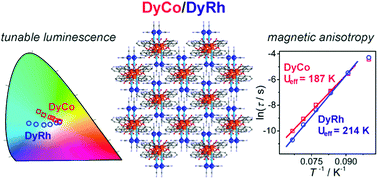当前位置:
X-MOL 学术
›
J. Mater. Chem. C
›
论文详情
Our official English website, www.x-mol.net, welcomes your feedback! (Note: you will need to create a separate account there.)
Achieving white light emission and increased magnetic anisotropy by transition metal substitution in functional materials based on dinuclear DyIII(4-pyridone)[MIII(CN)6]3− (M = Co, Rh) molecules†
Journal of Materials Chemistry C ( IF 6.4 ) Pub Date : 2017-11-18 00:00:00 , DOI: 10.1039/c7tc03963h Junhao Wang 1, 2, 3, 4, 5 , Szymon Chorazy 6, 7, 8, 9 , Koji Nakabayashi 1, 2, 3, 4, 5 , Barbara Sieklucka 6, 7, 8, 9 , Shin-ichi Ohkoshi 1, 2, 3, 4, 5
Journal of Materials Chemistry C ( IF 6.4 ) Pub Date : 2017-11-18 00:00:00 , DOI: 10.1039/c7tc03963h Junhao Wang 1, 2, 3, 4, 5 , Szymon Chorazy 6, 7, 8, 9 , Koji Nakabayashi 1, 2, 3, 4, 5 , Barbara Sieklucka 6, 7, 8, 9 , Shin-ichi Ohkoshi 1, 2, 3, 4, 5
Affiliation

|
A building block approach has led to the construction of two unique bifunctional magneto-luminescent molecular materials, {[DyIII(4-pyridone)4(H2O)2][MIII(CN)6]}·nH2O (M = Co, n = 2, 1; M = Rh, n = 4, 2), incorporating the cyanido-bridged dinuclear {DyIIICoIII} (1) or {DyIIIRhIII} (2) molecules, that crystallize within the supramolecular network in the attractive non-centrosymmetric Cmc21 space group. Both compounds reveal dual physical properties of colour-tunable photoluminescence and slow relaxation of magnetization. While 1 exhibits multi-coloured photoluminescence ranging from yellow to blue, tuned by the excitation wavelength, 2 additionally reveals nearly white light emission under 336 nm excitation at room temperature. 1 and 2 show 4f-metal-centered strong magnetic anisotropy presenting Single-Molecule Magnet (SMM) behaviour with the large anisotropic energy barriers of 187(6) K for 1, and 214(4) K for 2. We have shown and discussed that the replacement of [CoIII(CN)6]3− by the heavier [RhIII(CN)6]3− analogue in {[DyIII(4-pyridone)4(H2O)2][MIII(CN)6]}·2H2O crystalline materials is an efficient route towards white light emissive solid state matrices composed of Single-Molecule Magnets with enhanced magnetic anisotropy. Such extraordinary photoluminescent molecule-based magnets can become good prerequisites for future application in bifunctional optical and magnetic devices.
中文翻译:

通过基于双核Dy III(4-吡啶酮)[M III(CN)6 ] 3-(M = Co,Rh)分子的功能材料中的过渡金属取代,实现白光发射和增加的磁各向异性†
一种构造方法导致了两种独特的双功能磁致发光分子材料{{Dy III(4-吡啶酮)4(H 2 O)2 ] [M III(CN)6 ]}· n H 2 O的构建。(M = CO,ñ = 2,1 ; M = RH,ñ = 4,2),纳入cyanido桥联的双核{镝III钴III }(1)或{镝III的Rh III }(2)分子,它们在有吸引力的非中心对称Cmc 2 1空间群中的超分子网络内结晶。两种化合物都具有可调节颜色的光致发光和磁化缓慢弛豫的双重物理特性。虽然1展示了由激发波长调整的从黄色到蓝色的多色光致发光,但2额外显示了在室温下336 nm激发下的近白光发射。1个2示出的4f-金属中心强磁性各向异性呈现单分子磁体(SMM)行为与187(6)K的大各向异性能量壁垒1,和214(4)K为2。我们已经示出和讨论了更换[CO III(CN)6 ] 3-由较重的[Rh III(CN)6 ] 3-类似物在{[镝III(4-吡啶酮)4(H 2 O)2 ] [M III(CN)6 ]}·2H 2 O晶体材料是通向由具有增强的磁各向异性的单分子磁体组成的白光发射固态矩阵的有效途径。这种基于光致发光分子的非凡磁体可能成为将来在双功能光学和磁性设备中应用的良好先决条件。
更新日期:2017-11-18
中文翻译:

通过基于双核Dy III(4-吡啶酮)[M III(CN)6 ] 3-(M = Co,Rh)分子的功能材料中的过渡金属取代,实现白光发射和增加的磁各向异性†
一种构造方法导致了两种独特的双功能磁致发光分子材料{{Dy III(4-吡啶酮)4(H 2 O)2 ] [M III(CN)6 ]}· n H 2 O的构建。(M = CO,ñ = 2,1 ; M = RH,ñ = 4,2),纳入cyanido桥联的双核{镝III钴III }(1)或{镝III的Rh III }(2)分子,它们在有吸引力的非中心对称Cmc 2 1空间群中的超分子网络内结晶。两种化合物都具有可调节颜色的光致发光和磁化缓慢弛豫的双重物理特性。虽然1展示了由激发波长调整的从黄色到蓝色的多色光致发光,但2额外显示了在室温下336 nm激发下的近白光发射。1个2示出的4f-金属中心强磁性各向异性呈现单分子磁体(SMM)行为与187(6)K的大各向异性能量壁垒1,和214(4)K为2。我们已经示出和讨论了更换[CO III(CN)6 ] 3-由较重的[Rh III(CN)6 ] 3-类似物在{[镝III(4-吡啶酮)4(H 2 O)2 ] [M III(CN)6 ]}·2H 2 O晶体材料是通向由具有增强的磁各向异性的单分子磁体组成的白光发射固态矩阵的有效途径。这种基于光致发光分子的非凡磁体可能成为将来在双功能光学和磁性设备中应用的良好先决条件。



























 京公网安备 11010802027423号
京公网安备 11010802027423号